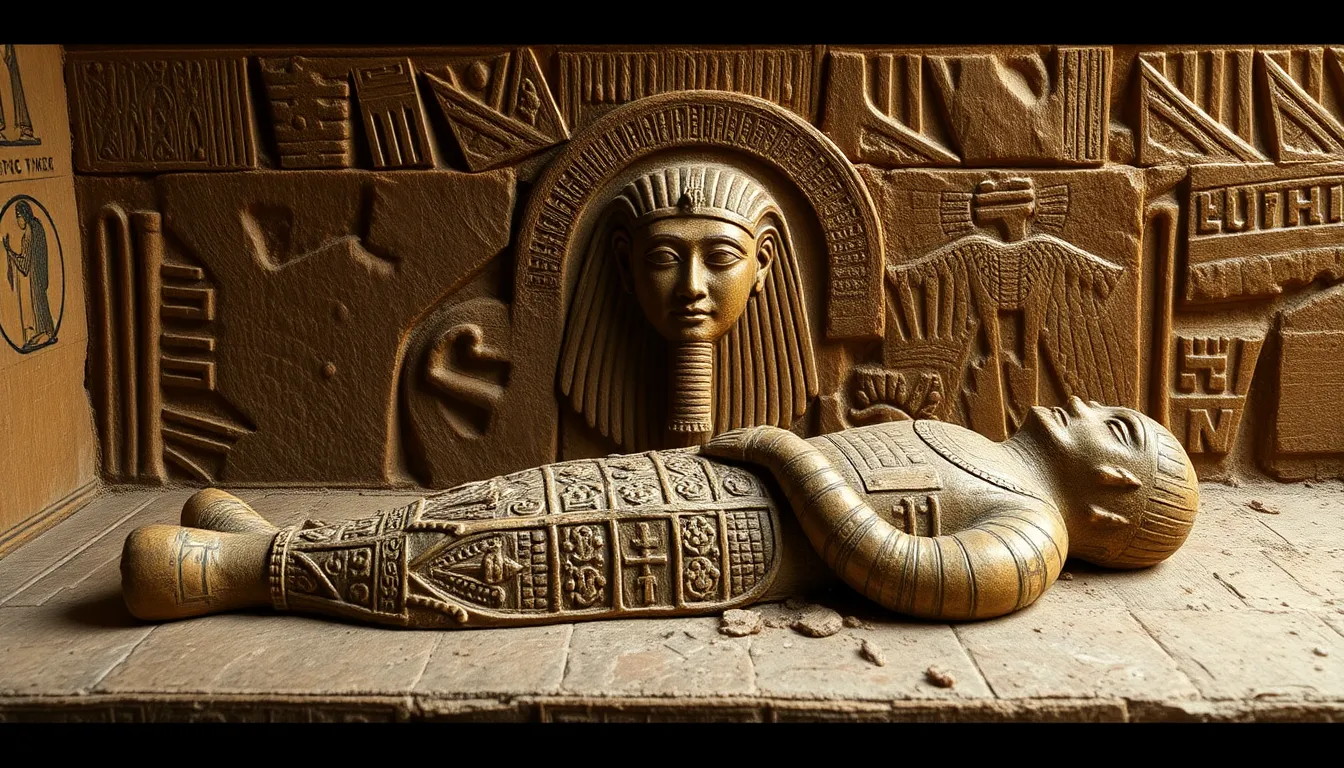The Role of Funerary Literature in Mummification
I. Introduction
Funerary literature refers to the various texts, inscriptions, and rituals that were created to accompany the dead in their journey to the afterlife. This literature played a crucial role in the ancient Egyptian belief system, particularly in relation to their elaborate mummification practices. Mummification, the process of preserving the body for eternity, was deeply intertwined with funerary literature, as it aimed to ensure a successful transition to the afterlife.
II. Historical Context of Mummification
The practice of mummification in ancient Egypt has its roots in a desire to honor the dead and prepare them for life after death. The origins of mummification can be traced back to the prehistoric period, evolving significantly over millennia. Early practices involved simple burial techniques, but as the Egyptian civilization developed, so too did their mummification methods.
- Origins: The earliest forms of mummification were likely accidental, stemming from natural preservation in arid environments.
- Evolution: Over time, techniques became more sophisticated, incorporating embalming fluids, removal of internal organs, and wrapping with linen.
- Significance: Mummification reflected cultural beliefs about the afterlife, with the body needing to be preserved for the soul to recognize it in the next world.
III. Understanding Funerary Literature
Funerary literature encompasses a diverse range of texts that were integral to the mummification process. These texts served not only as guidance during rituals but also as a means to communicate with the divine.
- Types of Funerary Literature:
- Texts: These include the Pyramid Texts, Coffin Texts, and the Book of the Dead.
- Inscriptions: Often found on tomb walls, these inscriptions were meant to invoke protection and blessings.
- Hymns: Religious hymns were recited to honor the deceased and appeal to the gods.
- Major Examples: The Book of the Dead is perhaps the most famous example, providing spells and instructions for navigating the afterlife.
- Language and Symbolism: The language of funerary texts was rich in symbolism, often using metaphors and imagery to convey complex spiritual concepts.
IV. The Connection Between Funerary Literature and Mummification Practices
The relationship between funerary literature and mummification is profound. Funerary texts were not merely supplementary to the mummification process; they were essential in shaping the rituals involved.
- Guidance in Rituals: Funerary texts provided step-by-step instructions for performing mummification rituals, ensuring that nothing was overlooked.
- Spells and Prayers: Specific spells were recited during the embalming process to protect the deceased from malevolent forces.
- Physical and Spiritual Connection: The preservation of the physical body was believed to be necessary for the soul’s survival, reflecting the deep-seated belief in the duality of existence.
V. Funerary Literature as a Reflection of Cultural Values
Funerary literature offers a window into the values and beliefs of ancient Egyptians regarding life, death, and the afterlife.
- Beliefs about the Afterlife: The texts reveal a structured view of the afterlife, with a journey that involved judgment, challenges, and rewards.
- Social Status: The content of funerary texts often reflected the deceased’s social standing, with elaborate inscriptions reserved for the elite.
- Societal Norms: The practices and beliefs encapsulated in funerary literature indicate broader societal values, including the importance of the afterlife and legacy.
VI. Archaeological Discoveries and Funerary Texts
Archaeological finds have provided significant insights into the practices surrounding mummification and funerary literature.
- Significant Finds: Discoveries such as the tomb of Tutankhamun and the pyramids of Giza have yielded invaluable artifacts and texts.
- Interpretations: The texts found in tombs have been interpreted to understand the beliefs and practices of ancient Egyptians regarding death.
- Case Studies: Specific tombs, like that of Seti I, have revealed rich funerary literature, shedding light on the complexities of mummification rituals.
VII. The Legacy of Funerary Literature in Modern Understanding of Mummification
The influence of funerary literature extends into contemporary scholarship, shaping our understanding of ancient practices and beliefs.
- Informing Scholarship: Funerary texts continue to be crucial for historians and archaeologists studying ancient Egyptian civilization.
- Modern Perceptions: These texts influence how modern society views death, preservation, and the rituals associated with them.
- Preservation Efforts: Ongoing translation and preservation efforts ensure that these ancient texts remain accessible for future research.
VIII. Conclusion
The interplay between funerary literature and mummification reveals the complexities of ancient Egyptian beliefs and practices. These texts were not mere artifacts of a bygone era; they were vital components of a culture that revered the afterlife and invested in the preservation of the body as a means to ensure eternal existence. As we continue to study these ancient practices, it becomes evident that funerary literature holds enduring significance in understanding the cultural and historical contexts of ancient civilizations.




